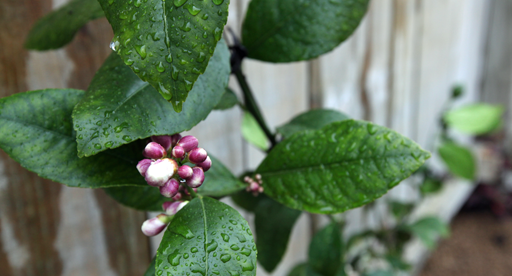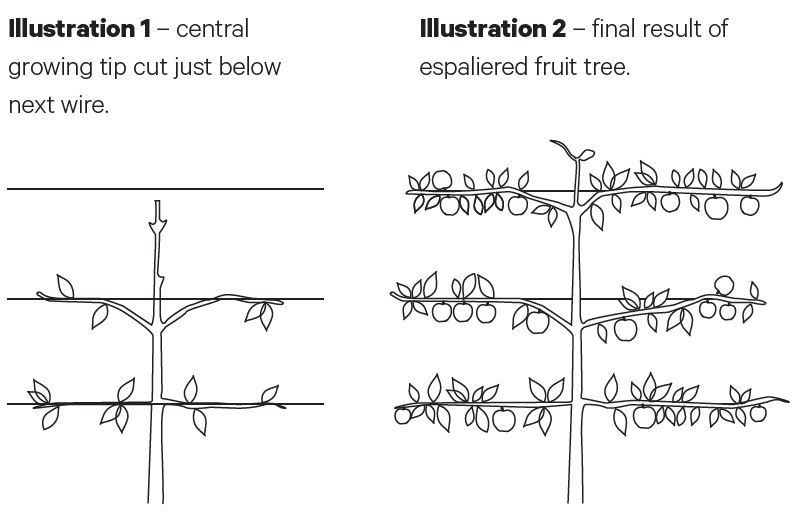
Whether you create your own mini-orchard, or choose to grow a few in pots on your balcony, fruit trees are fun to grow and can give many years reward of fresh, juicy homegrown fruit!
For those with a smaller space, looking to cover a fence, or even just looking to create a bit of theatre in the garden, espaliering is a great option. Find out how to espalier fruit trees below.
Prepare
1. Select a fruit tree, apples and pears both work well. Choose an upright growing variety with a straight stem, with two branches on opposite sides lower down on the stem, and ideally another two approximately 30cm higher.
2. Train wire along your fence, approximately 30cm apart. Ensure the lowest wire is at the same height as the bottom two branches you want to train.
Plant
3. The best times to plant are early in the morning or late in the day, so your tree isn't exposed to the hot sun straight away. Soak your tree in a bucket of Tui Organic Seaweed Plant Tonic to help prevent transplant shock.
4. Dig a hole approximately twice the depth and width of the root ball of the tree and partly fill with Tui Garden Mix. This has all of the essential nutrients your fruit trees need to get off to the best start.
5. Place the tree in the hole, and fill in with Tui Garden Mix, ensuring the tree is no deeper than it was in the container or bag.
6. Train the lower branches along the lower wire, and the next two branches along the second wire.
7. If you were able to find a tree with more sets of branches 30cm apart, continue onto the third, fourth wire etc. However if not (and the more likely scenario) you will need to cut the central growing tip (at the top of the tree) just below the next wire, making sure there are nodes (where the leaf comes out from the tree) below the cut so new branches can grow and be trained along the next wire.
Nourish
8. Plants use nutrients from the soil as they grow, so replenishing the nutrients ensures your fruit trees grow to their full potential. Feed your tree with Tui NovaTec Premium fertiliser in spring and summer.
9. Don’t forget to water your tree too – especially over the warm summer months.
Tui Tips
- If you have a branch on one side, but not one on the other, in spring you can cut a notch, as shown, and this will force a branch.
- The weather, weeds, pest insects and diseases can all impact on the success of your fruit trees. Protect your fruit trees from the elements with layers of Tui Mulch & Feed, to help keep their roots moist. Keep the area around your tree weed free.
Illustrations on how to espalier:

Find out when and how to prune your fruit trees here
- Jan
- Feb
- Mar
- Apr
- May
- Jun
- Jul
- Aug
- Sep
- Oct
- Nov
- Dec
- Harvest in 2-4 years
Shopping list
- Tui Garden Mix
- Tui Organic Seaweed Plant Tonic
- Tui NovaTec Premium fertiliser
- Tui Mulch & Feed,
- wire, nails, hammer, secateurs and ties.
Download a printable PDF guide here
Post a comment
Fruit Tree Espalier Guide Comments
I have learnt how to espalier my apple tree but how do I prune it for the next season? Do I cut back all those extra bits that have sprung up all over the tree?
Kath
Hi Kath, espalier trees benefit from summer pruning and winter pruning. In summer if you cut back the long branches that shoot up, a fruiting spur should appear and so cut back above the fruiting spur. Vegetative growth are long skinny branches, fruiting spurs are shorter fatter stubby branches. Prune to maintain shape.
Tui Team
Can you tell me if you can espalier a plumb tree?
Harry
Hi Harry, apples and pears are most suited for espaliering because they have more flexible branches. Stone fruit such as peaches, plums, nectarines and cherries are not as suited as their branches are brittle and this can be harder to train horizontally.
Tui Team
We've done a plum it's awesome
Ann
I have three espalier plum trees, two were several years old when we started altering the shape. The third tree was young and therefore no hassle to start the shaping. The local bird population were having a feast every year - something had to be done and it worked!
Sylvie Taylor
Hi there. So what exactly did you do that helped with your bird problem? We are in the same situation, so disheartening seeing all our efforts go to feeding the birds!
sandra
Hi Sandra, this is a perennial problem, as we don't want to discourage birds to the garden because they are important pollinators for many fruit trees, such as feijoas, but they also like to help themselves when the fruit ripens. A few things to try are feeding the birds in another area of the garden away from the fruit trees, they will get used to you putting food out for them in that spot and hopefully stay away from your fruit trees. Don't feed birds fruit that you grow in your own garden, for example, mandarin segments if you have mandarin trees. Place shiny objects in the tree that spin or twirl, such as tin foil pie dishes, humming tape, old CD's, spinning reflective rods or birds-eye scarers, owls and hawks also work - these will be available for purchasing on line or from farm merchants such as Fruit Fed. Place organza bags over the fruit to protect them, these can be purchased from garden centres and $2 shops. If space allows, plant enough trees to share with the birds, don't leave over-ripe or rotting fruit on the tree or on the ground. Good luck protecting your fruit trees this season.
Lianne, Tui Team
What do I do about the strong growth that shoots upwards along the branches I've tried down for espalier pear? How much do I remove ?
Hazel Lucy
Hi Hazel, these vigorous shoots are called water shoots and can be removed completely, as close to the branch of the tree as possible. Pear trees will always want to shoot for the stars and grow upwards. Water shoots are not fruitful and tend to dominate the trees growth. If wanting to generate new branches to reinvigorate the tree or create new fruiting wood, the water shoots can be tied down to grow horizontally and trimmed back by about one third. Pears will fruit on the same fruiting spurs for about 10 years. Pear trees fruit better on horizontal branches, so they are a great candidate for espaliering.
Tui Team
Tui Team
Hi, can a navel orange be espaliered? Thanks.
Dave Boyd
Hi Dave, yes, citrus can be espaliered, it would be best to select a tree that has been grown on dwarf rootstock, pick a tree that is upright and has a good framework for espalier. Consider what type of espalier you want to create, whether it is the traditional tiered system or a fan system, either way, you will need to provide a good framework for the tree to grow up against and time will need to be spend training and trimming to get the desired effect.
The Tui Team
Thanks very much, learnt a lot.
Haldane Rowan
I have a 3 year old apricot and nectarine tree that I have espaliered. The spring growth overtakes and all the new growth and coming forward. If i cut these all off I suppose I will have no growth next year, but there is too many to keep. Which ones do I cut off, and how many do I leave, or do I cut all the old branches and only leave the new growth?
donna
Hi Donna, you will still be developing the main framework for your trees as they are only three years old, so do not cut the old wood as that creates the framework for your espalier. Limbs need shortening each season, if you have over vigorous growth, thin it out so that the branches are evenly spaced, cut shoots back to two or three buds per branch. Apricots fruit on the previous seasons growth and will fruit for 3-4 years. Nectarines fruit on the previous seasons growth which is tinged red. As for apricots, shorten vigorous growth and evenly space out laterals. Fruiting spurs are plump and round, leaf buds tend to be elongated. Make sure you prune on a dry day using sharp tools, the best time to prune stone fruit is in summer after fruit is harvested.
Lianne